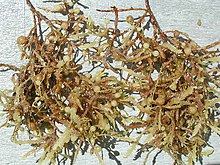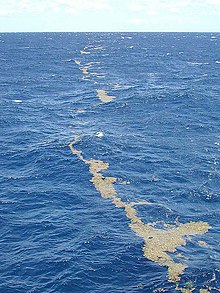| Sargassum | |
|---|---|

| |
| Scientific classification | |
| Domain: | Eukaryota |
| Clade: | Diaphoretickes |
| Clade: | SAR |
| Clade: | Stramenopiles |
| Phylum: | Gyrista |
| Subphylum: | Ochrophytina |
| Class: | Phaeophyceae |
| Order: | Fucales |
| Family: | Sargassaceae |
| Genus: | Sargassum C. Agardh |
| Species | |
|
See list | |
Sargassum is a genus of brown macroalgae (seaweed) in the order Fucales of the Phaeophyceae class.[1] Numerous species are distributed throughout the temperate and tropical oceans of the world, where they generally inhabit shallow water and coral reefs, and the genus is widely known for its planktonic (free-floating) species. Most species within the class Phaeophyceae are predominantly cold-water organisms that benefit from nutrients upwelling, but the genus Sargassum appears to be an exception.[2] Any number of the normally benthic species may take on a planktonic, often pelagic existence after being removed from reefs during rough weather. Two species (S. natans and S. fluitans) have become holopelagic—reproducing vegetatively and never attaching to the seafloor during their lifecycles. The Atlantic Ocean's Sargasso Sea was named after the algae, as it hosts a large amount of Sargassum.[3]
The size of annual blooms in the Atlantic increased by over a hundred-fold, starting in 2011, as a result of factors including increased fertilizer runoff in major rivers such as the Amazon and Congo. (need source)
- ^ Guiry, M.D.; Guiry, G.M., eds. (2023). "Sargassum C.Agardh, 1820, nom. et typ. cons". AlgaeBase. National University of Ireland. Retrieved 4 July 2023.
- ^ Hogan, C. Michael (2011). Monosson, E.; Cleveland, C.J. (eds.). "Algae § 1.3 Brown_algae". Encyclopedia of Earth. Washington DC: National Council for Science and the Environment.
- ^ "Sargasso". Straight Dope.

